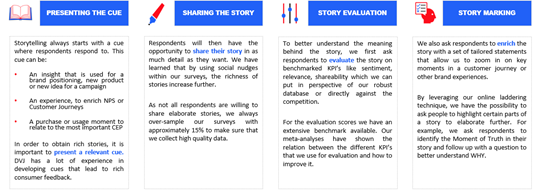INTRODUCTION
The goal of market research is to uncover new insights that support brands in making the right decisions. To obtain those insights, market research heavily uses traditional quantitative measures such as statements and questions. However, insights based on ‘how much,’ ‘how often,’ and ‘who’ is often not enough. Insights about the underlying ‘why’ are getting more and more important in guiding smart business decisions.
APPLYING STORYTELLING IN LARGE-sCALE quantitative RESEARCH
The principle of Storytelling is that human memory is story-based. That is, information is indexed, stored, and retrieved in the form of stories. This implies that human memory is better suited for Storytelling than for responding to isolated statements and questions.
At DVJ Insights, we apply Storytelling as a response mechanism towards a stimulus, insight, category entry point or brand experience. Asking consumers to share their own experience, reaction, or vision in the form of a story is always a better, more direct reaction to any type of stimulus than prompting lists of pre-defined statements. Stories – by nature – will focus on those elements that matter most. Because we work with large sample sizes, the collected stories lead to a wealth of insights into the language of the consumer.
QUANTIFYING STORIES THROUGH RESPONDENT CLASSIFICATIONS
The power of Storytelling is not only that the response mechanism is unbiased and full of rich details, but DVJ also asks respondents to classify their own response in different ways like positive-negative, relevancy and willingness to share. These classifications lead to quantitative outcomes that can help to put the response into the perspective of our robust database or directly against the competition.
Storytelling can be enriched through story markers and online laddering. Using story markers we ask respondents to respond to their own story with a set of tailored statements. Through online laddering, we ask respondents to highlight certain parts of their story to elaborate further. This results in a variety of quantitative KPIs that can be used in analyses such as driver analyses, factor analyses or subgroup analyses. And because we ask respondents to classify their own stories, the internal validity is by definition very high: no one can give meaning to the stories better than respondents themselves.
Figure 1: An overview of the mechanics of Storytelling
TAKING STORYTELLING ANALYSES ONE STEP FURTHER through AI-POWERED Text Analytics
Text analytics is the (automated) process of extracting meaning out of large volumes of unstructured text and translating this into meaningful quantitative data. This data can then be used to uncover trends, patterns, and insights.
While the phenomenon of text analytics has been around since the 1950s, the prominence of text analytics has been on the rise since the early 2000s due to the increasing availability of immense amounts of qualitative web/social data, thereby increasing the demand for text analytics to make sense of this data. As well as the rapid technological developments that make it possible to efficiently interrogate this vast lake of qualitative consumer feedback through machine learning.
Within the realm of quantitative market research, the use of open ends has historically been discouraged and avoided because it takes too long to code and analyse open ends, making it too expensive and time-consuming for large-scale surveys. Furthermore, individual human coder interpretations and classifications often lead to subjectivity bias that impacts the usability and validity of the quantified constructs.
Fortunately, we are now entering a pivotal moment in market research. We no longer need to force respondents to solely respond to long, boring grids of pre-defined statements that are not in line with how consumers feel and think without comprising on time, investments, and validity.
We apply text analytics to clean, code and model the unstructured qualitative data from our Storytelling technique as follows:
- The text data is thoroughly cleaned and thus perfectly prepared for topic modelling.
- Synonyms, antonyms, word families and explanations of terms are determined based on context and machine learning.
- While the AI-powered algorithms scan the text data, they already construct meaningful sections that are internally coherent and have as little overlap as possible.
- Themes are distilled and titled from these useful classifications. The AI outputs them together and enriches the dataset with respondent-level characteristics that can be used in a variety of analyses.
By combining our unique Storytelling approach with AI-powered text analytics, we can maximise the value of our Qual-at-Scale philosophy, without compromising on costs or timings.
By using text analytics, we offer our clients the unique possibility to truly explore Category Entry Points, identify key drivers and barriers of category and brand usage or bring a relevant theme to life in the language of the consumer. The quantified output from text analytics plays a crucial role in quantifying the results in terms of size and importance in a valid, consistent way. Leading to concrete and actionable recommendations for our clients, supporting them to decide where to play and how to win.



